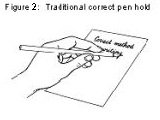Sometimes children who are left-handed can find handwriting difficult. Having to push the pen across the page towards their body can be awkward for them. Changing their body, paper or hand position for writing, their pen hold or changing the equipment they use can all help them achieve a fast, fluent writing style.
Body position
Left-handed writers should:
- Sit with light coming from the right-hand side, to avoid working in the shadow of their hand.
- Sit on a slightly higher chair than a right handed writer, to see over their hand more easily and so their arm and hand have more freedom of movement.
- Sit slightly to the right of the desk space so they have plenty of room to their left.
- Sit on the left hand side of right-handed writers – to avoid their paper and elbows bumping.
- Not sit in a hunched or stiff way. Usually this happens because the paper position isn't right.
Equipment
- Try different types of pens, to see how they affect your child's writing. Avoid using fountain pens for left-handed children – use ones especially for left-handers. Attaching a 'pencil-grip' can help if the pencil/pen is slippery.
- Write on a pad of paper or something similar that provides a smooth surface that 'gives' a little.
- Writing on a sloping surface can help. You can buy sloping writing surfaces or perhaps use a ring binder turned sideways.
Books with advice for left-handed people on a variety of topics are available, including those by handwriting expert Beverley Sassoon, author of 'Helping your Handwriting'. You can also buy equipment specifically designed for left-handers.
Paper position
A key way of improving handwriting by left-handers is by positioning the paper correctly.

- Place the paper alongside your child on the left.
- Push the paper away from them slightly.
- Turn the paper so the top is angled to the right towards the table.
This allows freer movement and for the writing to be more vertical. Your child's hand is in a more comfortable position below the writing, making it easier for them to see what's being written and avoid smudging.
If your child has developed a 'hooked hand' position (with their hand above the writing line) and finds it difficult to change, there is one method of 'hooking' better than others. To encourage this:
place the paper as for right-handed writers
ask your child to place their wrist on its edge rather than flat
flex the wrist when writing.
A smooth pointed pen – for example, ball-point – should be used, rather than a fountain pen.
Pen hold and hand position
Does your child:
- say it hurts to write
- have to stop often when writing
- want to write faster
- find their handwriting is distorted because the pens restricts the movement of the arm?
Different ways of holding the pen may help avoid these. Your child will need to experiment to find the best way for their fingers, wrist and arms to move freely and loosely.
The traditional way of holding a pen – the 'tripod grip' (see figure 2) – has the thumb and first finger placed either side of the pencil and the middle finger underneath.

Left-handed children should be encouraged to:
- Hold the pen so that the first finger is closer to the end point than their thumb.
- Hold the pen slightly further away from the point, than a right hander would.
- Position the wrist by rotating the hand slightly towards the paper.

There is another pen hold to consider (see figure 3) which has the pen placed between the first and middle finger, resting on the thumb.

